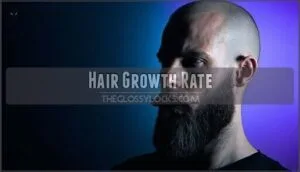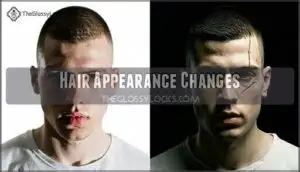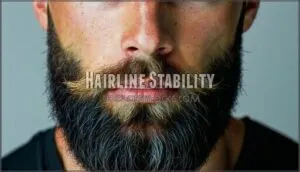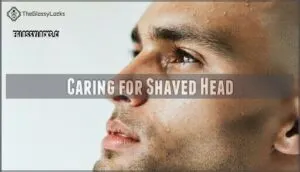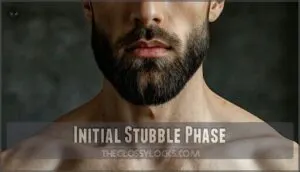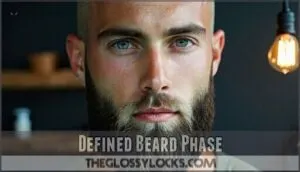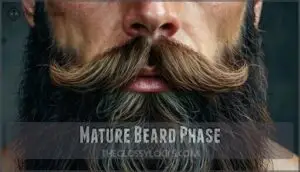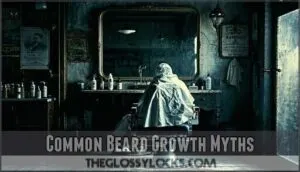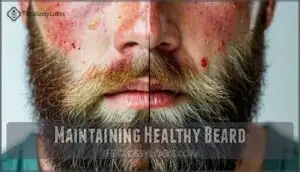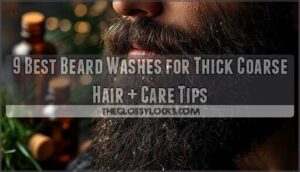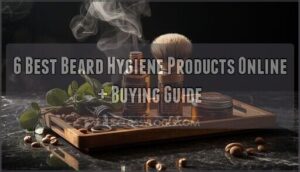This site is supported by our readers. We may earn a commission, at no cost to you, if you purchase through links.
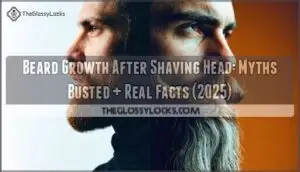
Your facial hair operates on its own schedule, completely separate from what’s happening on your scalp. The connection between beard growth after shaving head is purely coincidental, not causal.
Your beard’s destiny depends on genetics, testosterone levels, and age, not your haircut choices.
Think of it like this: your head and face are different neighborhoods with their own housing codes.
When you buzz your dome, you’re not sending a memo to your chin. The real secrets to maximizing your beard potential lie in understanding the science behind facial hair growth.
Table Of Contents
- Key Takeaways
- Shaving Head Effects
- Beard Growth Factors
- Shaving and Regrowth
- Caring for Shaved Head
- Beard Growth Stages
- Nutrition for Beard Growth
- Lifestyle Impact on Beard
- Common Beard Growth Myths
- Maintaining Healthy Beard
- Frequently Asked Questions (FAQs)
- Does a beard grow faster after shaving?
- What is the 3 month beard rule?
- Does hair grow back normally after shaving your head?
- What does a 2 month beard look like?
- Does shaving head affect beard growth speed?
- Can head shaving increase facial hair density?
- Will beard texture change after head shaving?
- Does scalp shaving boost testosterone for beards?
- Can head hair removal improve beard thickness?
- Conclusion
Key Takeaways
- You can’t make your beard grow faster or thicker by shaving your head—they’re completely separate systems controlled by different genetic and hormonal factors.
- Your beard’s destiny depends on genetics, testosterone levels, and age, not your haircut choices, so don’t expect head shaving to send growth signals to your facial hair.
- What looks like thicker regrowth after shaving is just an optical illusion caused by blunt-cut ends appearing denser than naturally tapered hair tips.
- You’ll maximize your beard potential through proven strategies like proper nutrition, regular exercise, stress management, and quality sleep rather than relying on shaving myths.
Shaving Head Effects
When you shave your head completely bald, you might wonder if this drastic change affects how your beard grows back.
The truth is, shaving your scalp doesn’t magically boost your facial hair growth, but it can create some interesting visual effects that make your beard appear different as it regrows, particularly in terms of beard growth patterns.
Hair Regrowth Patterns
After your head shave, hair regrowth follows predictable patterns determined by your genetic predisposition and hormonal influence.
Your growth cycle remains unchanged—typically half an inch monthly. External factors like nutrition and stress affect regrowth speed, but shaving doesn’t alter fundamental patterns.
Beard growth continues independently, unaffected by your head shave decision. Your follicles maintain their original programming regardless.
Shaving only trims the hair, and doesn’t affect follicles, which is a key point to understand about hair growth, as it is influenced by hormonal influence and genetic predisposition.
Hair Thickness Perception
After shaving your head, you’ll notice an optical trick that fools everyone.
After shaving your head, you’ll discover a clever visual illusion that tricks both you and everyone around you.
Your hair’s blunt ends create a stubble effect that makes regrowth appear thicker than it actually is.
This regrowth illusion stems from visual density – freshly cut hair lacks the tapered tips of natural growth.
The hair diameter remains unchanged, but your beard thickness perception gets completely warped by this clever disguise.
Hair Color and Texture
You’ll notice your hair color and texture remain unchanged after shaving your head.
Genetics control these traits, not your razor, determining natural pigments that decide whether your hair’s dark or light, while genetic influence shapes texture from fine to coarse.
Sun exposure and chemical treatments can alter appearance, but your follicles stay consistent, following the same genetic blueprint as your shaved head, which also applies to your beard growth.
Beard Growth Factors
Your beard’s destiny isn’t written by your razor, but by factors you can’t control and some you can influence.
While genetics loads the gun and testosterone pulls the trigger, your age acts like the safety—determining how fast and full your facial hair actually grows, influenced by factors such as testosterone.
Genetics Role
Your beard growth genetics aren’t something you can change – they’re written in your DNA.
About 50-60% of your Growth Potential comes from Paternal Influence, so look at dad’s facial hair for clues.
Your Ethnic Background also plays a huge role, while Androgen Sensitivity determines how your follicles respond to hormones.
These Inherited Traits shape your beard’s destiny.
Age Influence
While your genetic predisposition sets the foundation, age plays a starring role in your beard growth journey.
Younger guys typically see faster facial hair growth, with density increase peaking around 30.
After your mid-30s, expect some growth slowdown due to hormonal shifts.
Your maturation timeline means patience pays off – that patchy 20-year-old beard often fills out beautifully by 35, and this is where beard growth journey shows significant improvement.
Testosterone Impact
While age sets the stage, testosterone drives the show for facial hair growth.
Your hormone levels directly impact beard density and growth potential through DHT conversion in follicles.
Higher testosterone doesn’t guarantee a lumberjack beard though—receptor sensitivity matters more.
Think of testosterone as fuel, but your genetic engine determines how efficiently you’ll burn it after shaving your head.
Shaving and Regrowth
When you shave your head, your hair doesn’t magically grow back faster or thicker—it just looks different because you’ve cut it with a blunt edge instead of letting it naturally taper.
Your hairline won’t change either, since shaving can’t cure male pattern baldness or create new follicles where none existed before, which is a crucial point to understand about the effects of shaving on hair growth.
Hair Growth Rate
Your hair growth rate won’t change after shaving your head – that’s pure genetics talking.
Shaving creates the illusion of faster growth, but your follicles operate on their own timeline regardless of razor action.
- Genetic predisposition determines your baseline hair growth rate at approximately 0.5 inches monthly
- Hormonal influence from testosterone affects facial hair growth cycles more than scalp hair
- Nutritional impact can optimize existing growth potential but won’t override genetic limits
- Growth cycle phases remain consistent whether you’re sporting a shaved head or full mane
- Seasonal variation may slightly affect beard growth tips during winter months
Hair Appearance Changes
After shaving, you’ll notice dramatic changes in how your hair looks and feels.
Fresh stubble feels coarse and appears darker because of regrowth bluntness – those sharp, cut ends create a different texture than your natural tapered ends.
| Before Shaving | After Shaving |
|---|---|
| Soft, tapered ends | Sharp, blunt cuts |
| Natural hair color | Appears darker initially |
| Smooth texture | Coarse stubble perception |
| Varied hair angles | Uniform growth direction |
| Weathered hair tips | Fresh, unweathered ends |
This hairline illusion makes shaved hair texture seem thicker and more prominent.
Your facial hair growth follows the same pattern – that stubble perception tricks your eyes into thinking something’s changed permanently. But it’s just temporary visual magic.
Hairline Stability
Your hairline won’t budge after shaving your head. Male pattern baldness follows its own genetic blueprint, completely unaffected by your razor.
That receding hairline you’re worried about? It’s driven by DHT and genetic predisposition, not your grooming choices.
Here’s what actually impacts your hairline:
- Genetic predisposition determines hair loss patterns
- DHT blockers may slow recession progression
- Scalp health supports existing follicles
- Hair loss prevention requires targeted treatments
Caring for Shaved Head
Your freshly shaved head needs proper care to stay smooth and healthy, just like you wouldn’t skip moisturizing your face after a close shave.
You’ll want to treat your scalp with the same attention you’d give any other part of your skin, using gentle techniques and quality products to prevent irritation and maintain that clean, polished look.
Moisturizing Importance
Keeping your scalp moisturized after shaving creates the perfect foundation for healthy beard growth.
Your skin needs proper hydration to support hair follicles and prevent irritation that could slow regrowth.
| Hydration Benefits | Product Selection |
|---|---|
| Prevents flaking and irritation | Choose fragrance-free moisturizers |
| Supports healthy follicle function | Look for ceramides and hyaluronic acid |
| Maintains skin barrier protection | Avoid alcohol-based products |
| Reduces post-shave discomfort | Consider beard-specific moisturizers |
Proper moisture retention keeps your scalp healthy while your beard develops.
Many individuals seek gentle skincare options for this purpose.
Shaving Techniques
Getting smooth results requires the right approach and tools. Choose between a manual razor or electric shaver based on your comfort level.
Trim longer hair first, then wash with warm water before applying shaving cream. Keep your shaving angle consistent, rinse blades frequently, and check for missed spots.
Proper blade maintenance guarantees cleaner cuts every time. For superior results, consider pre-shave oil application to soften the hair, ensuring a smooth shave with proper technique.
Post-Shave Care
Your scalp’s newfound freedom demands immediate attention after the razor’s final pass.
Moisturize within minutes to prevent razor burn and maintain skin hydration.
Cool water rinses away debris while gentle exfoliation frequency of twice weekly prevents ingrown hairs.
Skip alcohol-based products that’ll leave your shaved head feeling like sandpaper.
Proper bald grooming sets the foundation for healthy beard growth and comfortable scalp care.
Using soothing shave balms can further reduce irritation.
Beard Growth Stages
Your beard doesn’t grow overnight, but it follows a predictable pattern that’ll help you plan your grooming routine.
Understanding these three main stages—from stubble to full beard—lets you know what to expect and when to start reaching for that beard oil.
Initial Stubble Phase
Your beard’s initial stubble phase kicks in within 24-48 hours after shaving your head.
Expect microscopic whiskers to emerge, creating that sandpaper feeling.
Stubble itch and early patchiness are totally normal during this beard growth stage.
Your shaved head won’t affect beard growth cycle timing.
Skin sensitivity peaks now, so resist frequent touching despite growth expectations running high.
Defined Beard Phase
After surviving the stubble gauntlet, you’ll enter the defined beard phase around weeks 2-4.
Your beard density becomes more apparent, though patchiness solutions like strategic styling techniques help camouflage thin spots.
Beard length reaches roughly half an inch, requiring a structured maintenance schedule.
Grooming challenges multiply as your shaved head contrasts with emerging beard styles, demanding patience and proper beard grooming routines.
Mature Beard Phase
Triumph awaits after months of patience.
You’ve reached the mature beard phase where beard density peaks and styling techniques become essential.
Patchiness solutions matter less now since your facial hair has filled in naturally.
Your beard styles options expand dramatically, making this the most rewarding of all beard growth stages.
Mature grooming requires a consistent maintenance schedule with proper beard care products.
Nutrition for Beard Growth
Your beard’s growth depends on more than just genetics—what you eat plays a vital role in how thick and healthy your facial hair becomes.
You can’t expect your beard to flourish on a diet of pizza and energy drinks, so focusing on specific nutrients like omega-3 fatty acids, zinc, and B-complex vitamins will give your whiskers the fuel they need to grow strong.
Essential Nutrients
Your body needs specific building blocks to fuel beard growth after you’ve shaved your head.
Vitamins like B-complex and D support hair follicles, while minerals such as zinc and iron boost growth.
Proteins provide the foundation for strong whiskers, and healthy fats keep follicles nourished.
Don’t forget hydration – water helps transport these nutrients to your facial hair roots, which is essential for beard growth.
Food for Healthy Beard
Your grocery cart becomes your beard’s best friend when you stock up on protein sources like eggs and lean chicken.
Healthy fats from salmon and avocados fuel follicle development, while leafy greens deliver vitamins your facial hair craves.
Don’t forget hydration – water transports nutrients to beard roots.
Zinc aids hair function, so consider incorporating foods rich in this mineral.
Smart food choices beat expensive beard products every time.
Vitamin and Mineral Importance
Your beard’s secret weapon isn’t just protein—it’s vitamin absorption and mineral balance.
Zinc deficiency can stunt hair follicle health, while vitamin D and B-complex vitamins fuel robust beard growth.
Diet optimization beats random supplements every time, as whole foods provide a more reliable source of essential nutrients like iron, biotin, and vitamin E, which work together like a well-oiled machine.
Skip the marketing hype and focus on supplement efficacy through whole foods first.
Lifestyle Impact on Beard
Your daily habits affect your beard growth more than you might think, whether you’re sporting a freshly shaved head or growing out facial hair.
Poor sleep, chronic stress, and skipping workouts can slow down your beard’s progress, while good lifestyle choices give your whiskers the boost they need to flourish, and this is influenced by factors such as chronic stress.
Exercise and Beard Growth
Working out regularly can supercharge your beard growth in surprising ways.
Your body responds to exercise by ramping up testosterone production and improving blood circulation to hair follicles.
Here’s how exercise boosts beard growth factors:
- Testosterone Boost – Resistance training increases hormone levels by 15-20%
- Blood Circulation – Cardio enhances nutrient delivery to follicles
- Stress Reduction – Regular workouts balance growth-supporting hormones
Stress and Beard Health
When stress kicks in, your beard pays the price.
Chronic stress pumps out cortisol, which messes with testosterone and DHT production—the hormones your facial hair craves.
This hormonal chaos can slow growth, create patchy spots, and even trigger hair loss.
Managing stress through lifestyle changes isn’t just good for mental health; it’s essential for healthy beard growth after shaving your head.
| Stress Impact | Effect on Beard | Solution |
|---|---|---|
| High Cortisol | Growth Inhibition | Meditation, Exercise |
| Low Testosterone | Patchy Growth | Stress Management |
| Poor Circulation | Weak Follicles | Regular Physical Activity |
| Nutrient Depletion | Brittle Hair | Balanced Diet |
| Hormonal Imbalance | Hair Loss | Professional Help |
The table outlines the impact of stress on beard health, including growth inhibition, and provides solutions such as meditation, exercise, and a balanced diet to mitigate these effects.
Sleep and Beard Regrowth
Quality rest acts as your beard’s secret weapon.
During deep sleep, your body cranks up hormone regulation and cellular repair processes that directly fuel hair growth. Poor sleep disrupts testosterone production and restricts blood flow to follicles.
Here’s how sleep supercharges your beard:
- Sleep Duration: Aim for 7-9 hours nightly for ideal hormone production
- Sleep Quality: Deep sleep stages trigger growth hormone release
- Hormone Regulation: Consistent sleep maintains testosterone levels naturally
- Cellular Repair: Nighttime recovery rebuilds damaged hair follicles
- Blood Flow: Rest improves circulation to facial hair roots
Common Beard Growth Myths
You’ve probably heard that shaving your head makes your beard grow thicker and faster, but these old wives’ tales are just that—tales.
Let’s clear up the most persistent myths about beard growth and shaving so you can make informed decisions about your grooming routine.
Shaving and Thickness
Contrary to popular belief, shaving your head won’t make your beard grow thicker.
This widespread myth stems from the Thickness Illusion created by Blunt Cut Ends after shaving.
When hair regrows, the Shaving Angle and Hair Diameter remain unchanged – your hair follicles determine actual thickness.
The Regrowth Appearance simply looks denser because stubble lacks natural tapered ends.
Shaving and Growth Rate
Here’s another myth that needs busting: shaving your head won’t turbo-charge your beard growth rate.
Your genetics and hormonal factors determine growth consistency, not shaving frequency.
Whether you’ve shaved your head once or daily, your facial hair follows its own regrowth timeline.
Think of it like a garden – watering more doesn’t make plants grow faster than their natural pace allows, which is influenced by your genetics.
Beard Growth and Age
Your beard growth potential peaks in your twenties and thirties, then gradually declines.
Beard maturation typically stabilizes around age 35, with peak growth occurring between 18-30.
After this sweet spot, age slowdown kicks in as hormonal shifts reduce testosterone levels.
Beard density may thin over time, but don’t panic – most men maintain decent facial hair well into their golden years, and this natural process is a part of life, affecting beard density.
Maintaining Healthy Beard
You’ve got your beard growing nicely, but keeping it healthy requires more effort than tossing it some leftover pizza crumbs.
Proper grooming, quality beard products, and smart itch prevention will transform your facial fuzz from scratchy disaster into a respectable masterpiece.
This approach will help maintain a healthy and respectable beard.
Regular Grooming
Once you’ve committed to growing your beard after shaving your head, consistent grooming becomes your secret weapon.
Regular maintenance keeps your facial hair healthy and looking sharp.
Here’s your essential grooming routine:
- Daily combing benefits – Train those wild whiskers and distribute natural oils evenly
- Strategic washing frequency – Clean every 2-3 days to avoid stripping essential moisture
- Smart trimming avoidance – Resist the urge to trim during early growth phases
Using one can provide noticeable beard benefits.
Beard Care Products
Essential beard care products transform your grooming game completely.
Beard oil moisturizes skin and hair, preventing flakiness while promoting healthy beard growth. Beard balm offers styling control plus conditioning benefits.
Wash frequency matters—2-3 times weekly keeps things fresh without overdrying. Quality comb selection prevents breakage, while proper styling tools shape your masterpiece.
A beard care kit can simplify grooming. These basics turn scraggly whiskers into magazine-worthy facial hair.
Preventing Beard Itch
When your beard starts sprouting after shaving your head, that notorious beard itch can drive you crazy.
Combat this by washing your beard 2-3 times weekly with gentle cleansers—over-washing strips natural oils.
Focus on hydration importance through quality beard oils containing jojoba or argan. Regular exfoliation benefits remove dead skin, while proper softening techniques keep whiskers manageable during sensitive beard growth phases.
Frequently Asked Questions (FAQs)
Does a beard grow faster after shaving?
Sorry to burst your bubble, but your beard won’t magically sprout faster after you’ve shaved.
Genetics control growth rate, not your razor.
Shaving just creates blunt ends that appear thicker—pure optical illusion.
What is the 3 month beard rule?
You’ll commit to growing your beard for three full months without trimming or styling.
This lets patchy areas fill in naturally and reveals your true growth potential before making any grooming decisions.
Does hair grow back normally after shaving your head?
Worried your buzz cut ruined everything? Don’t stress – your hair grows back completely normal after shaving your head.
Shaving only cuts hair at surface level, leaving follicles untouched and unchanged underneath.
What does a 2 month beard look like?
Your two-month beard shows defined growth patterns with some patchy areas still filling in.
You’ll notice fuller cheeks and a more structured jawline, though it’s not quite the mature beard you’ll achieve by month three.
Does shaving head affect beard growth speed?
Wondering if your fresh shave upstairs affects your facial fuzz?
Here’s the straight truth: shaving your head doesn’t influence beard growth speed whatsoever.
Your facial hair grows independently, following its own genetic timeline and hormonal cues.
Can head shaving increase facial hair density?
No, shaving your head won’t increase facial hair density.
Beard growth depends on genetics and hormones, not what happens on your scalp.
Your follicles operate independently, so head shaving has zero impact on beard thickness.
Will beard texture change after head shaving?
Think of your beard as a stubborn houseplant—it won’t magically transform just because you’ve given your scalp a fresh start.
Shaving your head doesn’t alter beard texture, thickness, or growth patterns whatsoever.
Does scalp shaving boost testosterone for beards?
No, scalp shaving doesn’t boost testosterone levels for beard growth.
Your hormone production isn’t affected by head shaving.
Beard growth depends on genetics, age, and existing testosterone levels, not whether you’ve got hair upstairs.
Can head hair removal improve beard thickness?
Like watering your lawn doesn’t make your garden vegetables grow faster, removing head hair won’t thicken your beard.
Beard thickness depends on genetics and hormones, not what’s happening on your scalp above.
Conclusion
Breaking through the fog of misinformation, you now understand that beard growth after shaving head isn’t connected.
Your facial hair follows its own genetic blueprint, fueled by testosterone and time, not your haircut choices.
Don’t wait for your bald dome to magically boost your beard—focus on proven strategies instead.
Eat well, exercise regularly, manage stress, and give your whiskers the care they deserve.
Your beard’s potential was written in your DNA long before you picked up that razor, and by following these tips, you can unlock your full beard potential.
- https://www.mayoclinic.org/healthy-lifestyle/adult-health/expert-answers/hair-removal/faq-20058427
- https://en.wikipedia.org/wiki/Hamilton%E2%80%93Norwood_scale
- https://my.clevelandclinic.org/health/diseases/24486-telogen-effluvium
- https://www.labiotech.eu/medical/hair-loss-drugs-innovation/
- https://us.movember.com/


